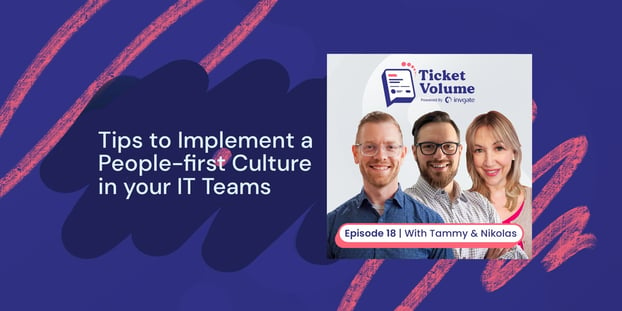It's no secret that IT teams are often considered the "anti-people" department within an organization. But what if your IT team could be a model of a people-first culture?
When people think of IT teams, the first thing that comes to mind is technology. However, people are the heart of any IT team — without them, all the technology in the world would be useless. So, in order to create a successful and productive IT team, this is the way to go.
It’s for that reason, the term people-first culture is thrown around a lot in today's business world. What does it mean? Simply put, a people-first culture is one in which the employees come before the needs of the company. This may sound like a recipe for disaster, but it's a proven way to create a more engaged workforce.
So how do you create this type of culture? It starts with managers. IT managers are uniquely positioned to impact employee experiences for the better.
Tammy Ward and Niko Miller chatted about that on the 18th episode of Ticket Volume, our tech podcast for Service Management professionals. Ward is currently Managing Director, Team Member Collaboration & Enablement at ATB Financial, where she's been a People Leader for the past nine years. Previously, she's been in many roles on a help desk for energy companies in Canada.
Former Best Buy Sales Associate, Nikolas Miller, is the Senior Manager of End-User Support at ATB Financial, where he has also served as Product Manager and IT Analyst since 2017.
They shared their experience with transitioning to this culture and gave fantastic tips along the way. Here is what we learned.
The benefits of implementing a people-first culture
If you manage an IT team, chances are good that you're always looking for ways to improve efficiency and effectiveness. Implementing a people-first culture is one way to do that, but according to Ward, it’s "a new level through disruption."
She knows this from experience: as part of their change management and experience management strategy, they switched from Microsoft to Google due to how the pandemic affected work dynamics. The reason for it is that it is a better environment for collaboration.
And there are many other benefits to implementing a people-first culture in your IT team. For one, it can help attract and retain top talent. Employees who feel valued and appreciated are more likely to stick around, which means less money spent on recruiting and training new hires.
It can also boost morale and motivation, leading to increased productivity. When people feel like they're part of a team that values them, they're more likely to be engaged in their work and invested in its success.
If you're interested, you can do a few things to get started:
- First, make sure your team members feel like they're part of the decision-making process. That means involving them in planning and goal setting, and giving them a voice in how work gets done.
- Second, focus on building relationships within the team. Strong relationships promote trust and open communication, both of which are essential for a successful team.
- Finally, ensure you're living the values you want your team to uphold. If you say that people are the priority, make sure your actions back that up.
Of course, creating a people-first culture is not a one-time event; it's an ongoing process that requires commitment from everyone in the organization. But if you want to see happier, more engaged employees, it's worth the effort.
How to implement a people-first culture in your IT team
If you want to implement a people-first culture in your IT teams, here are a few tips to get you started.
1. Bring people from across the organization together to plan the rollout
It should be a cross-section of people from different levels and roles within the organization. This means keeping them informed about decisions affecting them and regularly soliciting their feedback. With everyone on board, you can start implementing changes that will help create a more people-first culture in your IT teams. Some things you might want to consider include:
- Encouraging open communication and collaboration.
- Fostering a culture of respect and inclusion.
- Providing opportunities for professional development.
|
|
"When we actually went to Google, it was very much driven by our Chief Transformation Officer at the time — and our Chief Evangelist, who had been our chief people Officer before but he became the evangelist and Culture Evangelist for the organization. And so, it was very top driven from the decision-making, but because of the way they approached the rollout, it got everybody excited right from the ground up." Tammy Ward |
2. Go through personas and identify the needs of different types of users
Know that when your teams are happy and supported, they can do their best work. That's why you should invest in making sure they have the resources and support they need to be successful. But different people have different needs, so be sure to create a variety of programs and benefits to make everyone feel supported. From flexible job descriptions to enough vacation days, you need to be committed to these standards.
3. Train everybody on the new system
Focus on developing your team members' skills and abilities, and include how to use it and troubleshoot common problems. Encourage them to try new things and to stretch themselves professionally. This will not only make them better at their jobs, but it will also make them more engaged and invested in the team's success.
|
|
"My role through the whole G Suite was facilitating the bootcamp. But a big part was meeting with every executive, their executive assistants and board members as many times as they really needed to help them understand not only how to use the tool, but how to think about the work differently." Tammy Ward |
4. Make sure there's ongoing support available for users after the rollout
This can be in the form of a help desk or online resources. We recommend building a good knowledge base and improving how you write knowledge base articles.
But also be seen if these practices are adopted by everyone despite their rank.
5. Monitor adoption and user satisfaction levels
User satisfaction is a very important metric for IT teams to follow because it reveals how effectively the IT department is performing. By adopting better monitoring practices, you can enhance services because you know what users want and need. In other words, by understanding your employees better, you can provide them with a more satisfying experience overall. Over time, it will ensure that your IT team embraces the people-first culture.
6. Prepare for a new start now that the organization changed the way they work
Matt Beran, InvGate Product Specialist and Ticket Volume's host, called this a greenfield team since it is like starting from scratch at this stage. For that reason, another essential thing to remember is that your IT team will likely be responsible for much of the behind-the-scenes work that keeps things running smoothly. That means they need to be well organized and understand all the systems and processes in place.
This is where Niko Miller came into the picture. Back then, the definition of green was very much influenced by where he was at in his career. And he thinks it was unique — coming from a business background and then getting the chance to lead through product management. Obviously, that opportunity taught him a lot about what it means to support an organization.
|
|
"It was a unique opportunity to learn about support and user support. Obviously learned about leadership through Tammy, and then applied some of that mentality, and the values that came through, with people from the business, supporting the business, getting to embody that in a sense, which was a lot of pressure — although I was probably too naïve to realize it at the time — and then to bring people in." Niko Miller |
Ultimately, Ward and Miller structured their implementation steps in this disruptive order:
- Changing collaboration platforms.
- Doing design thinking.
- Making executives take the time to sit and think about work.
- Having someone run a bootcamp to change how people think about how they work.
- Start transitioning to insourcing and adding a deadline.
- Looking for new team members.
5 best practices for implementing a people-first culture
1. Encourage collaboration
People work best when they feel like they're part of a team. Encourage your team members to collaborate and share ideas openly. As the leader of an IT team, you can foster collaboration by taking the following steps:
- Provide opportunities for team-building activities. This allows team members to get to know each other and build relationships.
- Encourage teamwork. Make it clear that you expect team members to work together and support each other.
- Make sure everyone feels like they are part of the team by assigning tasks fairly and providing opportunities for everyone to contribute.
2. Respect differences
People have different backgrounds, experiences, and perspectives. Respect these differences and encourage open dialogue. It's about understanding that each team member brings different skills and perspectives to the table, and that those differences are essential to our success.
Here are some steps you can take to build a more diverse IT team:
- Define what diversity means to you and your organization.
- Understand the business case for diversity.
- Create recruiting strategies that focus on attracting diverse candidates.
- Implement unconscious bias training for all members of your team.
- Make sure your workplace policies and practices are inclusive of all employees.
- Celebrate the diversity of your team and the contributions each member makes.
- Continuously strive to build an even more diverse and inclusive team.
|
|
"It was really about building a diverse team of people that understood different elements and components, and could bring different things to the table." Niko Miller |
3. Recognize achievement
People are motivated by recognition. When your team feels appreciated and supported, they're more likely to go the extra mile to keep things running smoothly. Here are a few steps you can take to make sure your IT team feels valued:
- Acknowledge and celebrate your team's successes, big and small.
- Take the time to recognize individual achievements, and let your team know how much you appreciate their hard work.
- Make sure everyone knows when goals are met, and give credit where it's due.
4. Support growth
If you manage an IT team, it's important to provide opportunities for your team members to learn new skills and take on new challenges. This not only helps them grow professionally, but also makes your team more effective and efficient.
Here are some ways to provide learning opportunities for your team:
- Frequent constructive feedback: Give your team members regular feedback, so they can learn from their mistakes and continue improving.
- Coaching opportunities: Offer coaching or mentorship programs, so team members can learn from more experienced colleagues.
- Skill-building workshops: Host workshops on topics that will help team members build new skills.
- Informative conferences and webinars: Attend conferences and webinars together as a team, or allow team members to attend on their own.
- Encouraging membership in professional organizations: Help team members find professional organizations that align with their interests and encourage them to get involved.
5. Create clear communication channels and pathways
It's not just technical knowledge that's in high demand. Excellent communication skills are essential for anyone working in IT. After all, what good is having the best technical skills if you can't communicate effectively with other team members?
So, make sure everyone on your team feels comfortable speaking up and sharing their ideas. Encourage open dialogue and provide opportunities for feedback. It will help ensure everyone is on the same page and that information flows smoothly between team members.

Key takeaways
What is a people-first culture? In short, it's a way of doing business where the focus is on valuing employees and their contributions rather than profits or other bottom-line measures.
A people-first culture can lead to increased team morale, improved communication, and better overall performance. And, as we said, IT teams that put their people first are more likely to retain employees and attract top talent. Implementing it can be a challenge, but the benefits are well worth it.
Also, IT teams need to make sure they are hiring the right people and providing opportunities for growth. When they focus on their people, they create a culture of excellence that benefits everyone.
|
|
"What we know, and what we're convinced of, and we've seen over time (is that) we can teach people to do the account unlocks, the password resets, all the work that a service desk does. But what we can't teach is these underlying values of humble, hungry, smart that come from Patrick Lencioni's "Ideal Team Player." Niko Miller |
Frequently Asked Questions
What is a people-first culture?
A people-first culture is one where the needs of employees are always considered first and foremost. This type of culture can help improve employee satisfaction, retention, and overall company performance.
Why is it important to implement a people-first culture in IT teams?
IT teams are often pressured to perform at high levels and meet tight deadlines. This can lead to a lot of stress and burnout for team members. By implementing a people-first culture, you can help to reduce stress levels and create a more positive work environment.
How can you implement a people-first culture in your IT team?
There are a few key ways to implement a people-first culture in your IT team:
- Encourage open communication: Make sure team members feel comfortable communicating their needs and concerns.
- Promote work/life balance: Help team members to find a healthy balance between work and their personal lives.
- Provide support: Offer employees resources and support to help them deal with stress and burnout.
What challenges might you face when implementing a people-first culture in your IT team?
There are a few challenges you might face when implementing a people-first culture in your IT team:
- Resistance from team members: Some members may not accept entirely the change to a people-first culture.
- Limited resources: You may not fully have the budget or resources to support it.
- Time constraints: It can take time to implement this type of culture, and you may not be able to do so right away.
















